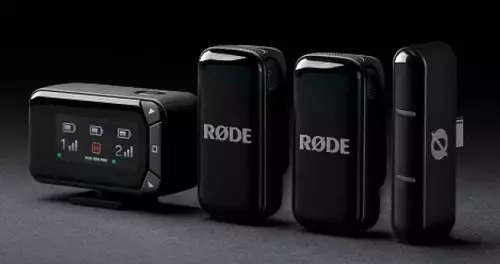Frage von Frank Glencairn:Blackmagic Design publishes the readout speed table of its newest cameras: URSA Cine 12K LF, and PYXIS 6K. The URSA Cine 12K LF appears to be a very fast camera with almost no rolling shutter artifacts, similar to global shutter performances.
Blackmagic URSA Cine 12K LF: Readout Speed (Res, Aspect, Max FPS, Pixel count, Sensor area, Readout in milliseconds):
12K, 3:2, 80, 12288 x 8040, Open Gate: 12.06
12K, 16:9, 90, 12288 x 6912, Full Width: 10.37
12K, 17:9, 100, 12288 x 6480, Full Width: 9.72
12K, 2.4:1, 120, 12288 x 5112, Full Width: 7.67
12K, 6:5, 80, 9648 x 8040, Full Height: 12.06
8K, 3:2, 144, 8192 x 5360, Open Gate: 6.75
8K, 16:9, 168, 8192 x 4608, Full Width, 5.81
8K, 17:9, 180, 8192 x 4320, Full Width: 5.44
8K, 2.4:1, 224, 8192 x 3408, Full Width: 4.29
8K, 6:5, 144, 6432 x 5360, Full Height: 6.75
4K, 3:2, 144, 4096 x 2680, Open Gate: 6.75
4K, 16:9, 168, 4096 x 2304, Full Width: 5.81
4K, 17:9, 180, 4096 x 2160, Full Width: 5.44
4K, 2.4:1, 224, 4096 x 1704, Full Width: 4.29
4K, 6:5, 144, 3216 x 2680, Full Height: 6.75
9K, 3:2, 100, 9408 x 6264, 4-perf Super 35: 9.4
9K, 16:9, 130, 8688 x 4896, 3-perf Super 35: 7.34
9K, 17:9, 130, 9312 x 4896, 3-perf Super 35: 7.34
9K, 2.4:1, 160, 9312 x 3864, 2-perf Super 35: 5.8
9K, 6:5, 100, 7680 x 6408, 4-perf Super 35: 9.61
Vergleich: URSA Mini Pro 12K:
12K, 17:9, Open Gate: 15.55ms
8K, 17:9, Open Gate: 7.78ms
4K, 17:9, Open Gate: 7.78ms
6K, Super 16: 7.78ms
Zum Vergleich; die Auslesezeit der Ursa Cine bei 8K, 17:9, 180, 8192 x 4320, Full Width, beträgt nur 5,44 ms.
Die RED V-Raptor hat eine Auslesezeit von 8 ms in dieser Auflösung.
Die ARRI ALEXA LF hat einen Wert von 7,5 ms (4K). Die Sony VENICE 2, hat eine Auslesegeschwindigkeit von 4 ms. und die BURANO hat 17,65.
Es gibt sogar eine noch schnellere Auslesung bei Aufnahmen im 8K-Format, 2,4:1 (Wert 4,29).
Antwort von iasi:
"Frank Glencairn" hat geschrieben:
Blackmagic Design publishes the readout speed table of its newest cameras: URSA Cine 12K LF, and PYXIS 6K. The URSA Cine 12K LF appears to be a very fast camera with almost no rolling shutter artifacts, similar to global shutter performances.
Blackmagic URSA Cine 12K LF: Readout Speed (Res, Aspect, Max FPS, Pixel count, Sensor area, Readout in milliseconds):
12K, 3:2, 80, 12288 x 8040, Open Gate: 12.06
12K, 16:9, 90, 12288 x 6912, Full Width: 10.37
12K, 17:9, 100, 12288 x 6480, Full Width: 9.72
12K, 2.4:1, 120, 12288 x 5112, Full Width: 7.67
12K, 6:5, 80, 9648 x 8040, Full Height: 12.06
8K, 3:2, 144, 8192 x 5360, Open Gate: 6.75
8K, 16:9, 168, 8192 x 4608, Full Width, 5.81
8K, 17:9, 180, 8192 x 4320, Full Width: 5.44
8K, 2.4:1, 224, 8192 x 3408, Full Width: 4.29
8K, 6:5, 144, 6432 x 5360, Full Height: 6.75
4K, 3:2, 144, 4096 x 2680, Open Gate: 6.75
4K, 16:9, 168, 4096 x 2304, Full Width: 5.81
4K, 17:9, 180, 4096 x 2160, Full Width: 5.44
4K, 2.4:1, 224, 4096 x 1704, Full Width: 4.29
4K, 6:5, 144, 3216 x 2680, Full Height: 6.75
9K, 3:2, 100, 9408 x 6264, 4-perf Super 35: 9.4
9K, 16:9, 130, 8688 x 4896, 3-perf Super 35: 7.34
9K, 17:9, 130, 9312 x 4896, 3-perf Super 35: 7.34
9K, 2.4:1, 160, 9312 x 3864, 2-perf Super 35: 5.8
9K, 6:5, 100, 7680 x 6408, 4-perf Super 35: 9.61
Vergleich: URSA Mini Pro 12K:
12K, 17:9, Open Gate: 15.55ms
8K, 17:9, Open Gate: 7.78ms
4K, 17:9, Open Gate: 7.78ms
6K, Super 16: 7.78ms
Zum Vergleich; die Auslesezeit der Ursa Cine bei 8K, 17:9, 180, 8192 x 4320, Full Width, beträgt nur 5,44 ms.
Die RED V-Raptor hat eine Auslesezeit von 8 ms in dieser Auflösung.
Die ARRI ALEXA LF hat einen Wert von 7,5 ms (4K). Die Sony VENICE 2, hat eine Auslesegeschwindigkeit von 4 ms. und die BURANO hat 17,65.
Es gibt sogar eine noch schnellere Auslesung bei Aufnahmen im 8K-Format, 2,4:1 (Wert 4,29).
Hat sich da etwas geändert seit diesen Angaben im BM-Forum vom 22.August?
https://forum.blackmagicdesign.com/view ... a475cd97ac
RES ASPECT MAX FPS PIXEL COUNT SENSOR AREA READOUT(MS)
12K 3:2 80 12288 x 8040 Open Gate 12.06
12K 16:9 90 12288 x 6912 Full Width 10.37
12K 17:9 100 12288 x 6480 Full Width 9.72
12K 2.4:1 120 12288 x 5112 Full Width 7.67
12K 6:5 80 9648 x 8040 Full Height 12.06
8K 3:2 144 8192 x 5360 Open Gate 6.75
8K 16:9 168 8192 x 4608 Full Width 5.81
8K 17:9 180 8192 x 4320 Full Width 5.44
8K 2.4:1 224 8192 x 3408 Full Width 4.29
8K 6:5 144 6432 x 5360 Full Height 6.75
Der Vergleich mit den 8 ms der Red Raptor hinkt übrigens, denn die Red hat einen Global Shutter und daher keinen RS-Effekt, bei dem die Auslesezeit eine Rolle spielt.
Somit ergibt sich, was das RS-Problem betrifft etwa diese Reihenfolge:
1. Red Raptor X
2. Sony VENICE 2
3. Ursa Cine 12K LF
4. Alexa LF
Wobei die Cine 12k LF auch 3:2 Open Gate bietet und dabei sehr flott ist.
Antwort von Frank Glencairn:
iasi hat geschrieben:
Der Vergleich mit den 8 ms der Red Raptor hinkt übrigens, denn die Red hat einen Global Shutter und daher keinen RS-Effekt, bei dem die Auslesezeit eine Rolle spielt.
Zunächst mal het RED nicht wirklich einen Global Shutter, sondern arbeitet mit ARM (All Rows Mode).
There is the option of using custom readout modes with CMOS sensors in order to image with a ‘pseudo global shutter mode’ (also called All Rows Mode). This solution combines the fast frame rates of a rolling shutter with the exposure simplicity of a global shutter, by only turning on the light source when all rows in the frame can be simultaneously exposed. This mode eliminates distortions from the rolling shutter effects, while still allowing much faster frame rates and lower read noise/dark current when compared to true global shutter sensors. Due to these advantages, most back-illuminated CMOS cameras operate with the pseudo-global shutter setup.
Aber auch ein echter Global Shutter (CCD/EMCCD) hat natürlich eine gewisse Auslesezeit, die bestimmt ist durch die Transferzeit der einzelnen Sensel.
Antwort von iasi:
"Frank Glencairn" hat geschrieben:
iasi hat geschrieben:
Der Vergleich mit den 8 ms der Red Raptor hinkt übrigens, denn die Red hat einen Global Shutter und daher keinen RS-Effekt, bei dem die Auslesezeit eine Rolle spielt.
Zunächst mal het RED nicht wirklich einen Global Shutter, sondern arbeitet mit ARM (All Rows Mode).
There is the option of using custom readout modes with CMOS sensors in order to image with a ‘pseudo global shutter mode’ (also called All Rows Mode). This solution combines the fast frame rates of a rolling shutter with the exposure simplicity of a global shutter, by only turning on the light source when all rows in the frame can be simultaneously exposed. This mode eliminates distortions from the rolling shutter effects, while still allowing much faster frame rates and lower read noise/dark current when compared to true global shutter sensors. Due to these advantages, most back-illuminated CMOS cameras operate with the pseudo-global shutter setup.
Aber auch ein echter Global Shutter (CCD/EMCCD) hat natürlich eine gewisse Auslesezeit, die bestimmt ist durch die Transferzeit der einzelnen Sensel.
Der GS zeichnet sich dadurch aus, dass alle Bilddaten auf einmal ausgelesen werden und die Rolling-Shutter-Effekte nicht auftreten.
Die Auslesezeit ist dann nur für die möglichen maximalen Bildraten von Bedeutung.
Bei 8ms sind dann eben nicht mehr als 125fps drin.
BMD schöpft wie Red, was die Frameraten betrifft, den Sensor voll aus.
Sony tut dies z.B. bei der Venice 2 nicht.
 |








